USB 3.2 Gen 2x2 State of the Ecosystem Review: Where Does 20Gbps USB Stand in 2020?
by Ganesh T S on October 5, 2020 10:30 AM EST- Posted in
- Storage
- SSDs
- Western Digital
- SanDisk
- ASMedia
- USB 3.2 Gen 2x2
PCMark 10 Storage Bench - Real-World Access Traces
There are a number of storage benchmarks that can subject a device to artificial access traces by varying the mix of reads and writes, the access block sizes, and the queue depth / number of outstanding data requests. We saw results from two popular ones - ATTO, and CrystalDiskMark - in a previous section. More serious benchmarks, however, actually replicate access traces from real-world workloads to determine the suitability of a particular device for a particular workload. Real-world access traces may be used for simulating the behavior of computing activities that are limited by storage performance. Examples include booting an operating system or loading a particular game from the disk.
PCMark 10's storage bench (introduced in v2.1.2153) includes four storage benchmarks that use relevant real-world traces from popular applications and common tasks to fully test the performance of the latest modern drives:
- The Full System Drive Benchmark uses a wide-ranging set of real-world traces from popular applications and common tasks to fully test the performance of the fastest modern drives. It involves a total of 204 GB of write traffic.
- The Quick System Drive Benchmark is a shorter test with a smaller set of less demanding real-world traces. It subjects the device to 23 GB of writes.
- The Data Drive Benchmark is designed to test drives that are used for storing files rather than applications. These typically include NAS drives, USB sticks, memory cards, and other external storage devices. The device is subjected to 15 GB of writes.
- The Drive Performance Consistency Test is a long-running and extremely demanding test with a heavy, continuous load for expert users. In-depth reporting shows how the performance of the drive varies under different conditions. This writes more than 23 TB of data to the drive.
Despite the data drive benchmark appearing most suitable for testing direct-attached storage, we opted to run the full system drive benchmark as part of our evaluation flow. Many of us use portable flash drives as boot drives and storage for Steam games. These types of use-cases are addressed only in the full system drive benchmark.
The Full System Drive Benchmark comprises of 23 different traces. For the purpose of presenting results, we classify them under five different categories:
- Boot: Replay of storage access trace recorded while booting Windows 10
- Creative: Replay of storage access traces recorded during the start up and usage of Adobe applications such as Acrobat, After Effects, Illustrator, Premiere Pro, Lightroom, and Photoshop.
- Office: Replay of storage access traces recorded during the usage of Microsoft Office applications such as Excel and Powerpoint.
- Gaming: Replay of storage access traces recorded during the start up of games such as Battlefield V, Call of Duty Black Ops 4, and Overwatch.
- File Transfers: Replay of storage access traces (Write-Only, Read-Write, and Read-Only) recorded during the transfer of data such as ISOs and photographs.
PCMark 10 also generates an overall score, bandwidth, and average latency number for quick comparison of different drives. The sub-sections in the rest of the page reference the access traces specified in the PCMark 10 Technical Guide.
Booting Windows 10
The read-write bandwidth recorded for each drive in the boo access trace is presented below.
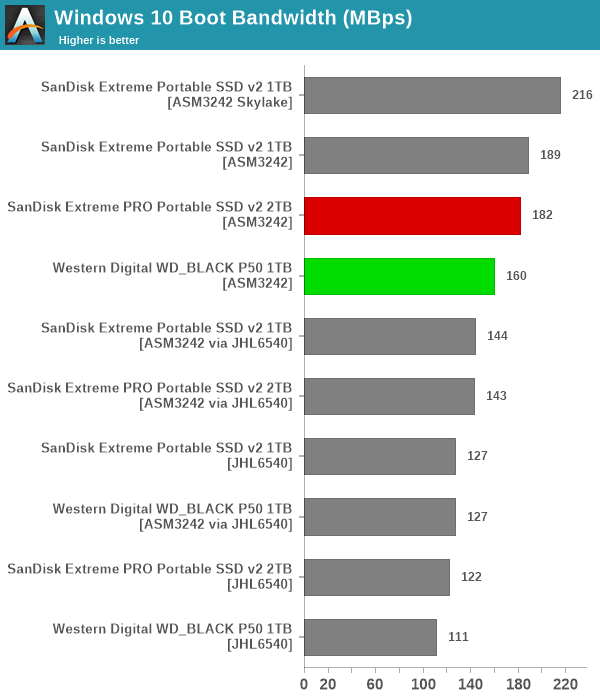
USB SuperSpeed 20Gbps doesn't matter for the boot process - in fact, the Extreme Portable SSD v2 using the SN550E behind a USB 3.2 Gen 2 (10 Gbps) bridge scores better than the P50 and the Extreme PRO v2 on the Haswell testbed in this benchmark.
Creative Workloads
The read-write bandwidth recorded for each drive in the sacr, saft, sill, spre, slig, sps, aft, exc, ill, ind, psh, and psl access traces are presented below.
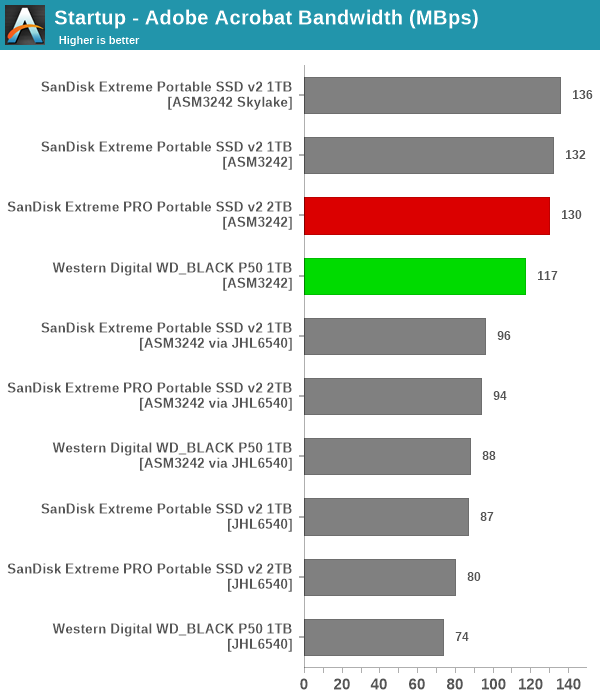
These workloads also seem to get little benefit from the move to USB SuperSpeed 20Gbps. In almost all cases, the SanDisk Extreme v2 performs better than the Extreme PRO v2 on the same testbed. The P50 seems to suffer from some handicaps for these types of workloads.
Office Workloads
The read-write bandwidth recorded for each drive in the exc and pow access traces are presented below.
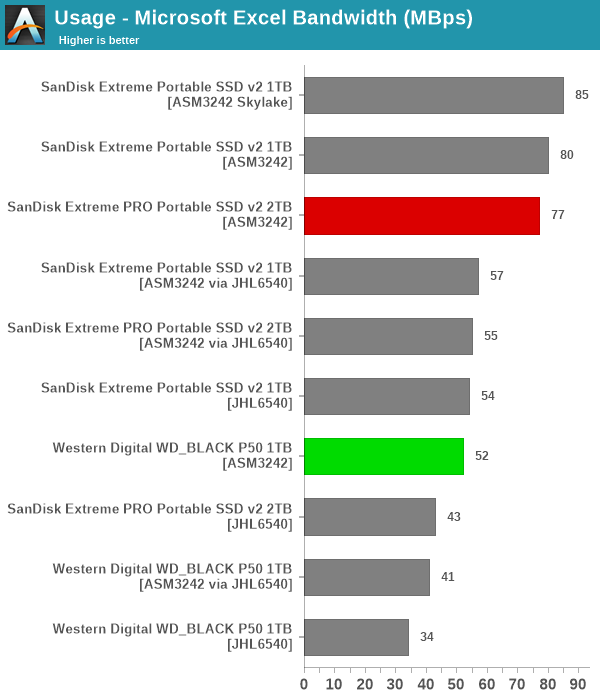
The trend seen in earlier PCMark 10 storage workloads repeats here - the Extreme edging out the Extreme PRO v2 slightly, while the P50 lags well behind.
Gaming Workloads
The read-write bandwidth recorded for each drive in the bf, cod, and ow access traces are presented below.
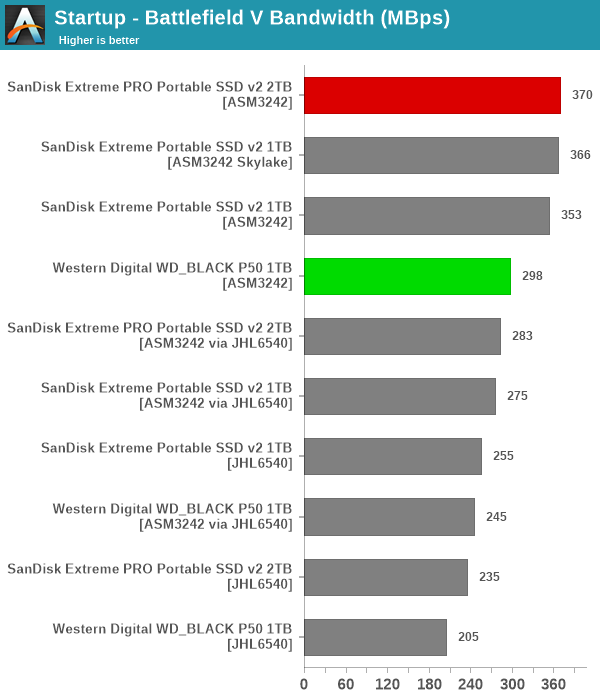
This section finally sees the P50 live up to its billing as a game drive - in the Call of Duty loading times, it finally scores almost as well as the Extreme PRO v2, and the Extreme v2 lags well behind. However, overall, the Extreme PRO v2 seems to be a better fit for gaming workloads.
Files Transfer Workloads
The read-write bandwidth recorded for each drive in the cp1, cp2, cp3, cps1, cps2, and cps3 access traces are presented below.
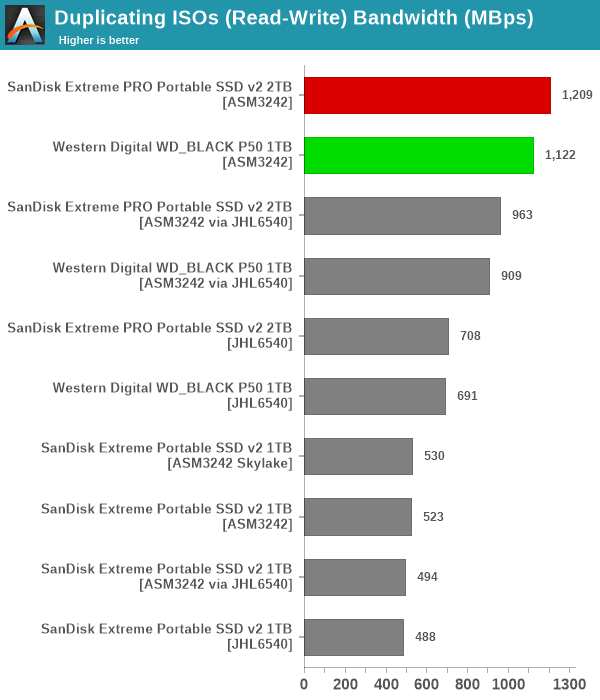
In most workloads, the USB SuperSpeed 20Gbps drives come out on top, with the Extreme PRO v2 slightly edging out the P50.
Overall Scores
PCMark 10 reports an overall score based on the observed bandwidth and access times for the full workload set. The score, bandwidth, and average access latency for each of the drives are presented below.
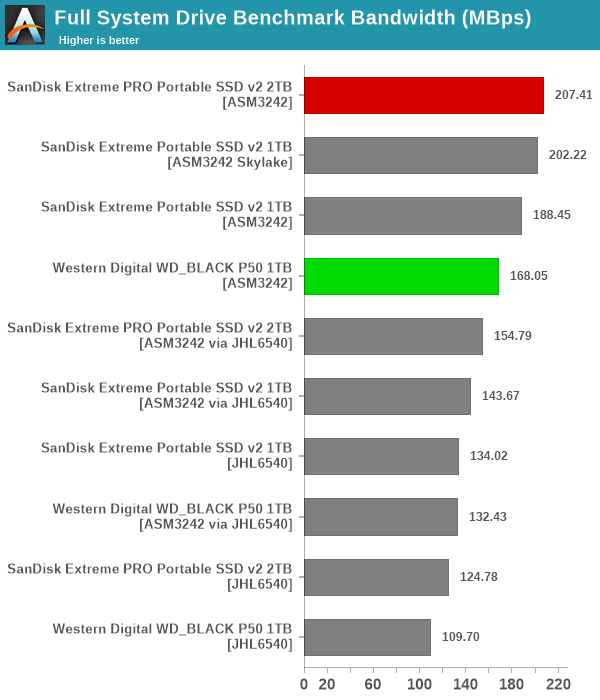
The WD_BLACK P50 scores are a bit behind the Extreme PRO v2 and the Extreme v2 when considered on a testbed-by-testbed basis. When limited by the host port to 10Gbps, the gulf is not significant, though. It may just be that Western Digital has tweaked the firmware of the P50 to cater to gaming workloads alone.










81 Comments
View All Comments
henkhilti - Monday, October 5, 2020 - link
Why do boot, office, PCMark10 runs.DAS is only about copying data from internal to external move the DAS to other system and do the opposite (copy data from external to internal).
Users don't have ram drives or use robocopy (you already have the synthetic benchmarks).
Just use fast internal drives (that people actually buy) and start dragging files/folders with File Explorer like humans do :)
repoman27 - Monday, October 5, 2020 - link
I boot from USB external media all the time. It's a pretty common part of many workflows. So is running VM's that reside on external media. Or working with large media files that live on external media dedicated to a particular project / client.hubick - Tuesday, October 6, 2020 - link
I was bike commuting from home to work with my SSD (Samsung X5 Thunderbolt 3) in my pocket and booting Linux off it at either end. Easier than trying to sync data, plus I only had to maintain the, like, 1000 development tools I need in once place.drajitshnew - Monday, October 5, 2020 - link
I have been reading Anandtech for 16 years now and this is the most outright confusing article that I have read for the reasons listed1. I disagree with the testbed choice-- IT IS NOT A SYSTEM,IT IS A HACK . I do not think that it has realworld applicability. Could you try a couple of Ryzen system. Failing that just stop giving 16 threads q32 results. I cannot think of a case where a 1 TB, bus powered DAS would be used in a realworld use requiring 16*32 random reads. Can you?
2. I agree with @danneely @spunjji @stormyparis, USB 3.2 is a mess. Even rtfm fails. I would request your reviewers to add the supported speeds to each system, board and flagship mobile review. With 8k video (and limited storage) it is not unthinkable to use one of these devices to transfer files.
ganeshts - Monday, October 5, 2020 - link
The article is a description of our attempts to make use of USB 3.2 Gen 2x2 as a regular consumer. Rarely do people go out on a limb and make a new PC for something that could be achieved with an expansion card. That is the reason for the piece being described as 'ecosystem review', rather than a review of just the WD_BLACK P50 and the SanDisk Extreme PRO v2.The testbed choice was an attempt to use the three 'direct-attached storage testbeds' we have used since starting the reviews set back in 2014. It did end up as a 'hack', but that serves the purpose of this particular review well. If you see many more Gen 2x2 reviews using the same Haswell testbed, then your complaint is justified.
AnandTech's editors do not operate out of a central location. Most (including me) are freelancers spread out throughout the world. As far as testing out a couple of Ryzen systems goes - all the Ryzen PCs with me are SFF machines without a PCIe expansion slot. I am loath to building a new testbed at *this point in time* because USB4 is just around the corner. It is better to build a testbed that can serve the purpose well for at least 2 to 3 years.
As for bus-powered DAS and the 4KQ32T16 workload - if you don't think it is suitable, feel free to disregard the numbers. The limited applicability of the workload is exactly the reason we felt it was OK to present the results from the other workloads on the same machine.
supdawgwtfd - Monday, October 5, 2020 - link
What editors?drajitshnew - Tuesday, October 6, 2020 - link
Thank you for addressing my concerns. In light of this I have 2 fresh ones1. As you also agree the host system is a hack-- it should not become the regular testbed. I do not bother with T16q32 results in any review, because I do not have any workload that can generate such a workload.
2. Please again I would like like that all devices with USB 3xyz are labelled with speeds and power output supported.
PaulHoule - Monday, October 5, 2020 - link
The issues they run into here make me think of the practical problems I have with USB.I have a few recent Windows laptops that have USB 3 Type A and Type C ports.
In the old days you were supposed to be able to plug a hub into a host then plug a hub into a hub and do it again and have it work. The spec said you could do it and you really could.
In the USB3 spec I don't see anything promised as to what kind of configurations are supported and I find I can't take it for granted that I plug my PC into a 4-way hub and can then plug my monitor into the hub and then plug my keyboard and mouse into the monitor.
Some configurations work but then I plug in the RealSense camera and my mouse stops working; or maybe the SD card reader connects and disconnects all the time and I am always hearing the notification tone for that.
The hard way I learned "at most four way hubs" and "never plug a hub into a hub" and I've finally settled in on something that works but plug in a USB hard drive and I pray that the filesystem doesn't get corrupted.
Let's see an expose on that!
eastcoast_pete - Monday, October 5, 2020 - link
I know this will read old-fashioned, but I really wish that one of these USB flavors would allow true "serial" use, i.e. the ability to daisy-chain USB devices directly in the plug. With most "ultraportables" now down to 1-2 ports, USB charging is often made absurd by the then-lost connectivity. If one could simply plug another device into the back of the male USB plug, that issue would be moot. Is there such a solution? I will gladly stay on 3.1 or 3.2 if that feature would be enabled.repoman27 - Monday, October 5, 2020 - link
In theory, they all do. You just need to embed a USB hub to create that topology. It costs money, adds complexity, and consumes power, but plenty of dongles and some chargers already do this.